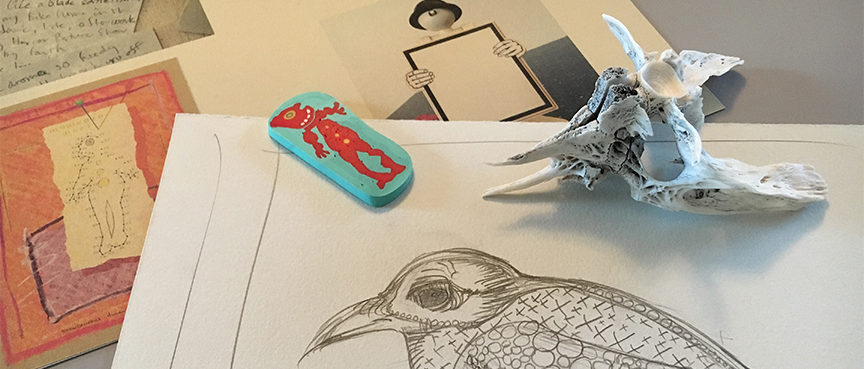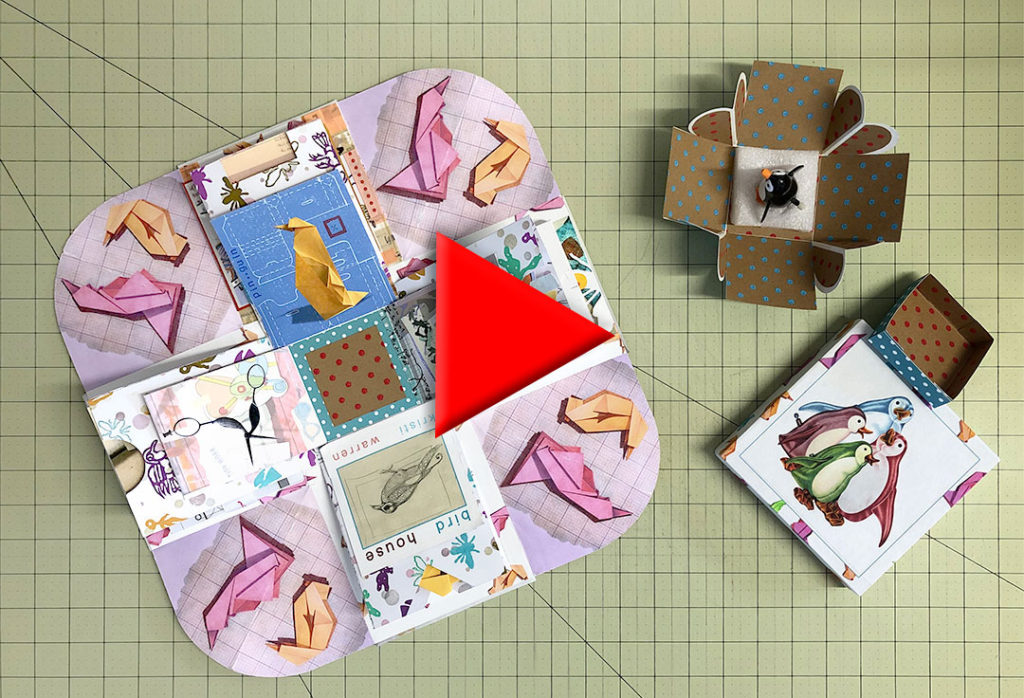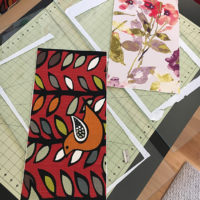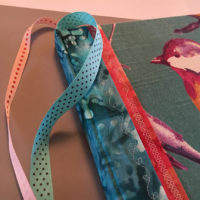Hardbound Explosion Box Part 2 – The Contents
This is part 2 of the hardbound Explosion Box. If you’ve missed Part 1 of this tutorial, which shows you how to construct the explosion box and lid, you can view it here.
Once you have the basic box made. It’s time to figure out how you want to fill it.
There is no single or right way to do this. You’re really only limited by your own creativity. But, this tutorial will show you some ways to get started, as well as some of the classic contents of an explosion box. This includes items like the Waterfall, and the Squash or Smash book.
Start with Some Base Layers
One way to give yourself a good start is to make a couple of base layers. These give you something to work with and something to attach individual items to.
I like to start with two basic layers, with the bottom-most layer made up of simple pockets that you can store flat things in, such as photographs. The next layer consists of just simple flaps that you can add items to. These two layers give your box a basic structure to work with, allowing you to add a wide variety of interesting items and objects.
You don’t want these two layers to stretch all the way to the edges of the box, like this:
If you do, the box won’t be able to close correctly because the hinges will be blocked from folding correctly. Instead, you want your inner layers inset about ½ inch from the corners so the box will fold correctly.
Base Layer Templates
So, here’s the basic template I use when making these base layers. You can download this template here. I’m basing these measurements off of a finished box size of 5x5x5, so the initial cardstock base, which is the outside of the box, is 15×15 inches, and each folded square area measures 5×5.
The first layer you create will be more complex than the second one because it allows for pockets to be created. You certainly don’t have to do this, but it makes for an extra place to put fun stuff.
This first layer will start out 1 inch smaller than your base each way. So, in my example of a 15×15 inch base, this pocket layer will start out at 14×14 inches, with the center square measuring 4×4 inches. All the other main folds are based off of this 4×4 center piece.
You’ll cut along the solid red lines and fold on all of the dotted lines. The area that you’ll cut off, shown as the pink area on this template, is ½ inch wide, and the fold next to it is also ½ inch wide. Figure out all your measurements accordingly.
So, measure and cut this piece of cardstock that you’ll use for the first layer that has the pockets. Score the folds with a bone folder to make it easier to make the folds. The folds will also be cleaner if you score them first. Fold along all of the scores and press them down with a bone folder to make them nice and sharp.
Next, cut off the excess ½ inch along the sides that you’ll fold over to make the pockets. Then, make the long cuts along the solid red lines, and score the folds along the edges that will become the flaps.
Use this template as a guide.
Once you have everything cut and folded you’ll probably want to decide if you want to make any additional cuts in the pockets before you glue down the flaps. I’ve made a variety of slots in the top edges of these pockets to make it easier to see items in the pockets and to get them in and out. You could also cut windows in the fronts of the pockets, if you wanted something to show through. €It’s easier to do this before you glue everything together.
So, use a barrier paper to protect the rest of the pocket from glue, and apply glue to the flap and also to the bottom edge, if you don’t want stuff falling out the bottoms of the pockets. You can use PVA glue for this or an acid-free glue stick. Fold the pocket top over and press down firmly. Follow this same procedure for the remaining pockets and weight the whole contraption down and allow it all to dry thoroughly.
Next you’ll want to cut and fold the second layer. This is just a simple cross shape that is smaller in all directions than the previous layer. In my example the main box is 5×5, so the square in the center of the first layer is 4×4 and the square in the center of the second layer is 3×3. Just gauge your measurements accordingly.
Once you have these two layers ready, the next step is to glue them onto your base. Start with the layer that has the pockets, turn it over and apply glue to the center square. You can use a barrier paper along the edges to keep glue off of the pockets. Center this piece on your base and press it down firmly. Place a weight on this while you get the next piece ready.
For this second layer, I keep the printed side down, because I normally glue other elements to the front tabs on this piece and I like having some kind of image on the back. You can certainly glue items to the backs of these tabs, as well.
So, turn this piece over and apply glue to the center square just as you did the first piece. I use barrier paper here so I don’t get glue on the tabs themselves.
Center this piece on the layer before it. It should be about ½ inch smaller all the way around if you followed my measurements. Press this down firmly and place weights on it to let it dry.
Now you can start adding various items to the structure you just created. The first thing I’ll show you how to make is the popular and easy to make Squash Book, a folded piece of paper that opens and closes like an accordion.
You can glue a squash book down to one of the sections of your explosion box so it can just be folded and unfolded in place or you can leave it detached, as I have with this one, so that the user can take it out and turn it over. I prefer this second method if the squash book has two important sides that I want to have seen.
I’ve used a ribbon strap with a magnetic snap here just to keep the book closed flat. You could also put it inside a small box, which I’ll also show you how to make in this video. I’ve added another ribbon clasp here that has a Velcro closure and is glued down to the explosion box to keep the little box in place. There are many different ways to include and attach items inside your explosion box.
You can print on your paper before you fold it or glue photos or images onto it after you have folded and glued it together. You can also make this from one large piece of paper or from several smaller pieces folded and then glued together. I’ll show you both methods, starting with how to fold a squash book from one large, continuous piece of paper.
To figure out the size of the whole paper, start with the size that you want your final squash book to be. For example, you might want the finished size to be 4×4 inches. Double this figure both directions to get the large square. So, that would be 8×8 in this example. The final size of the entire paper will be the equivalent of three of these larger squares overlapping.
Here is the folding pattern you’ll use if you’re creating this from one large sheet of paper. This shows the mountain folds as solid lines and the valley folds as dotted lines. By the way, this pattern is available for download on my website – the same link that you downloaded the box and lid worksheets, if you followed along with Part 1 of this tutorial.
So, if you’ve printed on your paper before you fold it, decide which side you want to have as the outside of the squash book once it’s folded. In this example, I wanted the colorful drawing to show on the outside, so I’m scoring the opposite side so the mountain folds, the solid red lines, will end up on the side with the color. Score all of the red lines on the pattern using a bone folder or other scoring tool.
After you’ve scored all of the folds indicated by the red lines, fold them over and flatten them using your bone folder, making nice sharp folds. These will be valley folds on the side facing you – in the case of the example, the floor plan side – but they are mountain folds on the other side, so don’t be confused by the pattern.
Turn the paper over and score and fold all of the dotted lines on the pattern.
Once you’ve creased all the folds you can collapse the entire contraption according to the folds. It should want to collapse naturally along the folds you’ve made, but the first time you do this it might need a little coaxing. Once you have it folded correctly press down the folds again with a bone folder. If the paper I’m using is thick, like the paper I’m using in this example, I’ll usually put this under a weight for a while to set the folds.
So, if you want to make this from smaller pieces of paper, your measurements will still be similar. Start from the same place – the size of your finished squash book, and double that dimension in both directions. That’s the size of your square piece of paper and you’ll want three pieces this size.
Fold each paper in half in both directions, using your bone folder to make a crisp fold.
Turn the square over and fold it diagonally in only one direction. When you collapse this it becomes a small square. Make this diagonal fold on the remaining two squares.
You now have three squares that are folded identically. Turn the middle piece over so that the folds are going the opposite way – what are mountain folds on the two outer pieces are valley folds on the center and the valley folds become mountain folds.
The next step is to glue these three pieces together, gluing them together at the small flat squares that don’t have a fold going through them. I’m using an acid-free glue stick for this.
Once you have the three pieces glued together you should be able to just collapse the pieces according to the folds into a small square. I will often burnish the folds again and also put a weight on the finished squash book to help the folds set and allow the book to lay flatter.
The next fun item for your explosion box is the Waterfall Card. This is simple to make but creates an interesting and complex effect once it’s glued into place. You’ll want to make this out of something at least as stiff as cardstock so that you’ll be able to push and pull it. Here’s the cutting template to give you an idea of how to figure out the measurements for your Waterfall card.
These example measurements are again based on an Explosion Box that is 5x5x5 inches. You’ll cut the main body from a piece of paper that is 4×10 inches. You won’t fold this exactly in half because the card itself will end up being only 4 ½ inches wide – you don’t want it to be the full 5 inches because once you install it in your Explosion Box that size would interfere with the closing of the box. So, that extra inch will be folded in half to create a tab to allow you to manipulate the waterfall effect.
Only one side of this main piece of paper will be seen, and that’s the inside of the waterfall card. The outside either has other items glued to it or is face down on your Explosion box, so this can be blank on one side.
I will usually mark the measurements on the back of the paper
Cut the main piece of cardstock and cut the corners from the tab section.
Then score along all of the main dotted lines shown in the template diagram. Do this with the right side facing up. The fold for the tab will be scored from the opposite side (the wrong side).
Press down the fold on the tab with your bone folder and glue this together. This double layer of paper will add some strength and substance to the tab. You can also add elements to the tab to make it stand out, like ribbon or eyelets.
Next, make all of the main folds, pressing them down with your bone folder, making nice crisp folds. Remember, the side that you want showing when this is finished goes on the inside, so make your folds accordingly. You should end up with four folds, one in the center, if you don’t count the extra little part for the tab.
Next, you’ll want to glue on the 3×4 pieces that you’ve cut. These cards can be photos or images, or they can be blank cards that you then glue images to. I prefer the second method just because it gives everything a bit more weight and stability, but either method will work.
Only one of these, the first one, will be glued down fully. So, place it on a piece of scrap paper and apply glue to the whole surface. You can use PVA or an archival glue stick for this. With the main piece folded in half, right side inside, place this card on the first 3×4 area, pressing it down firmly. You can put weights on this for a few minutes to make sure it’s firmly adhered.
The rest of the card will only be glued onto the small strips created by the folds. So, turn what you’ve glued so far over, exposing the next strip created by the folds. Apply glue to that strip – you can do that on a barrier paper or just hold the card up so you don’t get glue on anything else.
Attach the next card to that glued strip, aligning the edge with the fold, and press down firmly. Follow this same procedure for the last two cards and folds. Put a weight on all of this to let it dry.
Now the mechanism should open a page at a time, moving ½” each time you fold over one of the cards. You don’t really get the waterfall effect yet because you need to anchor this down to something with that last strip that you cut. We’ll do that in a minute.
But first, apply the images that you want on the cards. You don’t really have to do this right now, it’s just a little easier to do before you glue the whole thing down. I usually make these pieces a little smaller so they have a bit of a border around them.
I also apply whatever additions or decorations I want to the tab before I glue the whole thing down. In this case I applied eyelets to the tab. This makes it a little more substantial and also draws the eye so the user knows there’s something to do there, like pull on it. I’m using a great little tool called a Crop-a-dile to set these eyelets.
Now you’re ready to attach it to your explosion box so the whole mechanism will work the way it’s supposed to. You can attach this any direction that you want, but I find it works best from side-to-side. If you place it so the tabs pulls outward it will sometimes catch on other elements in the box when you are pushing it back in.
So, figure out exactly where you want to place the waterfall card so you can position the strip correctly. The strip should be positioned at the end of the card, right before the tab. This will be glued down to the explosion box just on the ends, because the card needs to be able to move back and forth underneath it. So, glue it down and then double-check that the card is moving freely underneath the strip.
The last step is to glue the edge of the card to the top of that strip. So, line it up again with the edge of the card so just the tab is sticking out and put glue along the area of the strip that will be covered by the top of the card. Don’t apply glue past where the edges of the card are and don’t get excessive about the application of glue on this strip! You don’t want glue gushing out onto other parts of the card. Use a barrier paper if necessary to keep this from happening.
Press this down firmly and weight it down to dry thoroughly.
Once it’s dry the waterfall card should move back and forth freely when you pull on the tab.
If you want to see more items that you can make for your explosion box, watch part 3!



